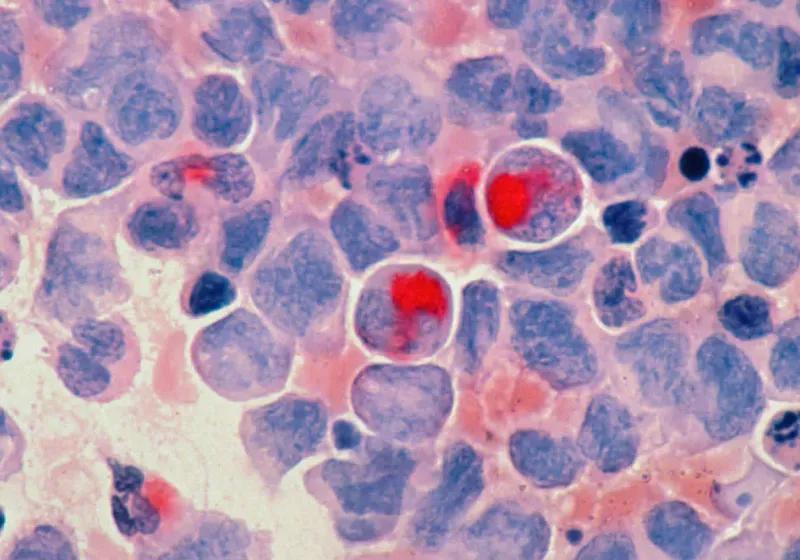Harvard's AI Model PDGrapher: Revolutionizing Drug Discovery for Complex Diseases
4 Sources
4 Sources
[1]
Harvard's new free AI tool could help treat Parkinson's, Alzheimer's, and even cancer
It can identify treatments to restore diseased cells to health. While AI's most common use cases involve helping people with their everyday tasks, it can also go far beyond that, even helping make medical breakthroughs. Also: Can AI outdiagnose doctors? Microsoft's tool is 4 times better for complex cases Last week, Harvard Medical School published a study on a new AI model called PDGrapher. According to Harvard, the model can analyze the connections between genes, proteins, and signaling pathways inside cells to identify the best combination of therapies that would effectively restore healthy cell behavior. This could enable new treatments for conditions that have previously been unable to be found via traditional methods. In a summary of the study, which was partially federally funded, the authors explain that usual drug discovery approaches tackle one protein at a time, and work in cases such as kinase inhibitors -- drugs that prevent cancer cells from expanding by blocking certain proteins -- but can fall short when the disease involves interactions between multiple signaling pathways and genes. "Traditional drug discovery resembles tasting hundreds of prepared dishes to find one that happens to taste perfect," said study senior author Marinka Zitnik in the summary. "PDGrapher works like a master chef who understands what they want the dish to be and exactly how to combine ingredients to achieve the desired flavor." Also: AI could dull your doctor's detection skills, study finds The researchers trained the model on a dataset of diseased cells before and after treatment so that PDGrapher could use that data to identify which genes transform cells from a diseased to a healthy state. Then the model was put to the test on 19 datasets spanning 11 types of cancers, where it was asked to predict various treatment options without having seen the cell samples before. The tool accurately predicted the drug targets known to work and identified other targets with clinical evidence to support them. PDGrapher also outperformed "other similar tools," the authors wrote (though they did not specify any), ranking the correct therapeutic targets up to 35% higher and 25 times faster. Also: AI's not 'reasoning' at all - how this team debunked the industry hype The researchers identified many ways PDGrapher can optimize drug discovery by identifying multiple targets that can reverse the disease. According to the post, this could speed up the process, streamline research efforts, and reduce instances in which complex diseases with multiple pathways, such as cancer, evade drugs. Currently, the team is using the model to tackle brain diseases, including Parkinson's and Alzheimer's. Though still new, AI has made several recent strides for medical use cases. Last year, for example, AI models' tendency to hallucinate actually helped Stanford researchers find new drug compounds at an exponentially faster rate than they could have with basic computing alone. At the same time, however, studies show AI chatbot users are perhaps over-reliant on AI tools for medical advice, which can be factually incorrect or otherwise unreliable, and does not replace information from a medical professional.
[2]
New AI model can identify treatments that reverse disease states in cells
Harvard Medical SchoolSep 10 2025 In a move that could reshape drug discovery, researchers at Harvard Medical School have designed an artificial intelligence model capable of identifying treatments that reverse disease states in cells. Unlike traditional approaches that typically test one protein target or drug at a time in hopes of identifying an effective treatment, the new model, called PDGrapher and available for free, focuses on multiple drivers of disease and identifies the genes most likely to revert diseased cells back to healthy function. The tool also identifies the best single or combined targets for treatments that correct the disease process. The work, described Sept. 9 in Nature Biomedical Engineering, was supported in part by federal funding. By zeroing in on the targets most likely to reverse disease, the new approach could speed up drug discovery and design and unlock therapies for conditions that have long eluded traditional methods, the researchers noted. Traditional drug discovery resembles tasting hundreds of prepared dishes to find one that happens to taste perfect. PDGrapher works like a master chef who understands what they want the dish to be and exactly how to combine ingredients to achieve the desired flavor." Marinka Zitnik, study senior author, associate professor of biomedical informatics in the Blavatnik Institute at HMS The traditional drug-discovery approach - which focuses on activating or inhibiting a single protein - has succeeded with treatments such as kinase inhibitors, drugs that block certain proteins used by cancer cells to grow and divide. However, Zitnik noted, this discovery paradigm can fall short when diseases are fueled by the interplay of multiple signaling pathways and genes. For example, many breakthrough drugs discovered in recent decades - think immune checkpoint inhibitors and CAR T-cell therapies - work by targeting disease processes in cells. The approach enabled by PDGrapher, Zitnik said, looks at the bigger picture to find compounds that can actually reverse signs of disease in cells, even if scientists don't yet know exactly which molecules those compounds may be acting on. How PDGrapher works: Mapping complex linkages and effects PDGrapher is a type of artificial intelligence tool called a graph neural network. This tool doesn't just look at individual data points but at the connections that exist between these data points and the effects they have on one another. In the context of biology and drug discovery, this approach is used to map the relationship between various genes, proteins, and signaling pathways inside cells and predict the best combination of therapies that would correct the underlying dysfunction of a cell to restore healthy cell behavior. Instead of exhaustively testing compounds from large drug databases, the new model focuses on drug combinations that are most likely to reverse disease. PDGrapher points to parts of the cell that might be driving disease. Next, it simulates what happens if these cellular parts were turned off or dialed down. The AI model then offers an answer as to whether a diseased cell would happen if certain targets were "hit." "Instead of testing every possible recipe, PDGrapher asks: 'Which mix of ingredients will turn this bland or overly salty dish into a perfectly balanced meal?'" Zitnik said. Advantages of the new model The researchers trained the tool on a dataset of diseased cells before and after treatment so that it could figure out which genes to target to shift cells from a diseased state to a healthy one. Next, they tested it on 19 datasets spanning 11 types of cancer, using both genetic and drug-based experiments, asking the tool to predict various treatment options for cell samples it had not seen before and for cancer types it had not encountered. The tool accurately predicted drug targets already known to work but that were deliberately excluded during training to ensure the model did not simply recall the right answers. It also identified additional candidates supported by emerging evidence. The model also highlighted KDR (VEGFR2) as a target for non-small cell lung cancer, aligning with clinical evidence. It also identified TOP2A - an enzyme already targeted by approved chemotherapies - as a treatment target in certain tumors, adding to evidence from recent preclinical studies that TOP2A inhibition may be used to curb the spread of metastases in non-small cell lung cancer. The model showed superior accuracy and efficiency, compared with other similar tools. In previously unseen datasets, it ranked the correct therapeutic targets up to 35 percent higher than other models did and delivered results up to 25 times faster than comparable AI approaches. What this AI advance spells for the future of medicine The new approach could optimize the way new drugs are designed, the researchers said. This is because instead of trying to predict how every possible change would affect a cell and then looking for a useful drug, PDGrapher right away seeks which specific targets can reverse a disease trait. This makes it faster to test ideas and lets researchers focus on fewer promising targets. This tool could be especially useful for complex diseases fueled by multiple pathways, such as cancer, in which tumors can outsmart drugs that hit just one target. Because PDGrapher identifies multiple targets involved in a disease, it could help circumvent this problem. Additionally, the researchers said that after careful testing to validate the model, it could one day be used to analyze a patient's cellular profile and help design individualized treatment combinations. Finally, because PDGrapher identifies cause-effect biological drivers of disease, it could help researchers understand why certain drug combinations work - offering new biological insights that could propel biomedical discovery even further. The team is currently using this model to tackle brain diseases such as Parkinson's and Alzheimer's, looking at how cells behave in disease and spotting genes that could help restore them to health. The researchers are also collaborating with colleagues at the Center for XDP at Massachusetts General Hospital to identify new drug targets and map which genes or pairs of genes could be affected by treatments for X-linked Dystonia-Parkinsonism, a rare inherited neurodegenerative disorder. "Our ultimate goal is to create a clear road map of possible ways to reverse disease at the cellular level," Zitnik said. Harvard Medical School Journal reference: Gonzalez, G., et al. (2025). Combinatorial prediction of therapeutic perturbations using causally inspired neural networks. Nature Biomedical Engineering. doi.org/10.1038/s41551-025-01481-x
[3]
Harvard's New AI Tool Could Pinpoint Treatments for Parkinson's and Alzheimer's - Decrypt
The tool adds to a wave of AI breakthroughs in biotech, from AlphaFold to generative drug discovery. Researchers at Harvard Medical School have unveiled a new artificial intelligence model that could reshape the future of personalized medicine by identifying precise combinations of genes and drugs capable of reversing diseased states in human cells. The system, called PDGrapher, was designed to tackle some of medicine's most intractable challenges: neurodegenerative diseases such as Parkinson's and Alzheimer's, along with rare conditions like X-linked Dystonia-Parkinsonism. Unlike traditional computational tools that simply flag correlations, the model goes a step further. It forecasts gene-drug pairings that can restore healthy cellular function, while also offering mechanistic insights into how those interventions might work. That dual capacity -- prediction plus explanation -- could prove critical as researchers push deeper into precision therapies. Drug discovery has historically been slow, expensive, and littered with false leads. By narrowing down viable combinations at the cellular level, PDGrapher promises to accelerate timelines and cut costs, while also pointing scientists toward entirely new therapeutic pathways. The breakthrough comes amid a surge of investment and innovation at the intersection of AI and biotechnology. Tools that once served language, finance, or image recognition are increasingly being adapted to map genetic networks, design proteins, and test drug candidates in simulations. Analysts say this trend could spark a "Cambrian explosion" in experimental therapies, especially as pharmaceutical companies seek more efficient pipelines for clinical research. Harvard's team has already begun testing PDGrapher against real biological datasets. Early results suggest it can highlight promising gene-drug combinations that align with known interventions, while also surfacing novel pairings yet to be validated in the lab. If confirmed through clinical trials, the approach could help shift medicine away from one-size-fits-all treatments toward tailored interventions rooted in each patient's unique biology. For now, PDGrapher remains a research tool. But its debut underscores how artificial intelligence is moving beyond general tasks into highly specialized domains -- where the payoff could be measured not just in efficiency, but in lives extended and diseases slowed. The work also echoes other recent breakthroughs where AI has upended long-standing scientific bottlenecks. Google DeepMind's AlphaFold has transformed protein structure prediction, while firms like Insilico Medicine are using generative AI to propose novel drug compounds. Together, these efforts hint at an emerging playbook: harness machine learning to decode biology's complexity faster than humans ever could. If PDGrapher delivers on its promise, then it may be the latest proof that AI isn't just augmenting science -- it's beginning to redefine its limits.
[4]
New AI Tool Pinpoints Genes, Drug Combos To Restore Health in Diseased Cells | Newswise
Newswise -- In a move that could reshape drug discovery, researchers at Harvard Medical School have designed an artificial intelligence model capable of identifying treatments that reverse disease states in cells. Unlike traditional approaches that typically test one protein target or drug at a time in hopes of identifying an effective treatment, the new model, called PDGrapher and available for free, focuses on multiple drivers of disease and identifies the genes most likely to revert diseased cells back to healthy function. The tool also identifies the best single or combined targets for treatments that correct the disease process. The work, described Sept. 9 in Nature Biomedical Engineering, was supported in part by federal funding. By zeroing in on the targets most likely to reverse disease, the new approach could speed up drug discovery and design and unlock therapies for conditions that have long eluded traditional methods, the researchers noted. "Traditional drug discovery resembles tasting hundreds of prepared dishes to find one that happens to taste perfect," said study senior author Marinka Zitnik, associate professor of biomedical informatics in the Blavatnik Institute at HMS. "PDGrapher works like a master chef who understands what they want the dish to be and exactly how to combine ingredients to achieve the desired flavor." The traditional drug-discovery approach -- which focuses on activating or inhibiting a single protein -- has succeeded with treatments such as kinase inhibitors, drugs that block certain proteins used by cancer cells to grow and divide. However, Zitnik noted, this discovery paradigm can fall short when diseases are fueled by the interplay of multiple signaling pathways and genes. For example, many breakthrough drugs discovered in recent decades -- think immune checkpoint inhibitors and CAR T-cell therapies -- work by targeting disease processes in cells. The approach enabled by PDGrapher, Zitnik said, looks at the bigger picture to find compounds that can actually reverse signs of disease in cells, even if scientists don't yet know exactly which molecules those compounds may be acting on. PDGrapher is a type of artificial intelligence tool called a graph neural network. This tool doesn't just look at individual data points but at the connections that exist between these data points and the effects they have on one another. In the context of biology and drug discovery, this approach is used to map the relationship between various genes, proteins, and signaling pathways inside cells and predict the best combination of therapies that would correct the underlying dysfunction of a cell to restore healthy cell behavior. Instead of exhaustively testing compounds from large drug databases, the new model focuses on drug combinations that are most likely to reverse disease. PDGrapher points to parts of the cell that might be driving disease. Next, it simulates what happens if these cellular parts were turned off or dialed down. The AI model then offers an answer as to whether a diseased cell would happen if certain targets were "hit." "Instead of testing every possible recipe, PDGrapher asks: 'Which mix of ingredients will turn this bland or overly salty dish into a perfectly balanced meal?'" Zitnik said. The researchers trained the tool on a dataset of diseased cells before and after treatment so that it could figure out which genes to target to shift cells from a diseased state to a healthy one. Next, they tested it on 19 datasets spanning 11 types of cancer, using both genetic and drug-based experiments, asking the tool to predict various treatment options for cell samples it had not seen before and for cancer types it had not encountered. The tool accurately predicted drug targets already known to work but that were deliberately excluded during training to ensure the model did not simply recall the right answers. It also identified additional candidates supported by emerging evidence. The model also highlighted KDR (VEGFR2) as a target for non-small cell lung cancer, aligning with clinical evidence. It also identified TOP2A -- an enzyme already targeted by approved chemotherapies -- as a treatment target in certain tumors, adding to evidence from recent preclinical studies that TOP2A inhibition may be used to curb the spread of metastases in non-small cell lung cancer. The model showed superior accuracy and efficiency, compared with other similar tools. In previously unseen datasets, it ranked the correct therapeutic targets up to 35 percent higher than other models did and delivered results up to 25 times faster than comparable AI approaches. The new approach could optimize the way new drugs are designed, the researchers said. This is because instead of trying to predict how every possible change would affect a cell and then looking for a useful drug, PDGrapher right away seeks which specific targets can reverse a disease trait. This makes it faster to test ideas and lets researchers focus on fewer promising targets. This tool could be especially useful for complex diseases fueled by multiple pathways, such as cancer, in which tumors can outsmart drugs that hit just one target. Because PDGrapher identifies multiple targets involved in a disease, it could help circumvent this problem. Additionally, the researchers said that after careful testing to validate the model, it could one day be used to analyze a patient's cellular profile and help design individualized treatment combinations. Finally, because PDGrapher identifies cause-effect biological drivers of disease, it could help researchers understand why certain drug combinations work -- offering new biological insights that could propel biomedical discovery even further. The team is currently using this model to tackle brain diseases such as Parkinson's and Alzheimer's, looking at how cells behave in disease and spotting genes that could help restore them to health. The researchers are also collaborating with colleagues at the Center for XDP at Massachusetts General Hospital to identify new drug targets and map which genes or pairs of genes could be affected by treatments for X-linked Dystonia-Parkinsonism, a rare inherited neurodegenerative disorder. "Our ultimate goal is to create a clear road map of possible ways to reverse disease at the cellular level," Zitnik said. Authorship, funding, disclosures Additional authors include Guadalupe Gonzalez, Xiang Lin, Isuru Herath, Kirill Veselkov, and Michael Bronstein. The work was funded in part by federal grants (NIH grant R01-HD108794, NSF CAREER 2339524, and US DoD FA8702-15-D-0001), ARPA-H BDF program, awards from the Chan Zuckerberg Initiative, the Gates Foundation INV-079038, Amazon Faculty Research, Google Research Scholar Program, AstraZeneca Research, Roche Alliance with Distinguished Scientists, Sanofi iDEA-iTECH, Pfizer Research, John and Virginia Kaneb Fellowship at HMS, Biswas Computational Biology Initiative in partnership with the Milken Institute, HMS Dean's Innovation Awards for the Use of Artificial Intelligence, Harvard Data Science Initiative, and the Kempner Institute for the Study of Natural and Artificial Intelligence at Harvard University. Partial support was received from the Summer Institute in Biomedical Informatics at HMS and from the ERC-Consolidator Grant No. 724228. Gonzalez is currently employed by Genentech, Inc., and Herath was employed by Merck & Co., Inc. during the study.
Share
Share
Copy Link
Harvard Medical School researchers have developed PDGrapher, an AI model that identifies treatments to reverse disease states in cells. This breakthrough could accelerate drug discovery for conditions like Parkinson's, Alzheimer's, and cancer.
Harvard's AI Model PDGrapher: A Game-Changer in Drug Discovery
Harvard Medical School researchers have unveiled a groundbreaking artificial intelligence model called PDGrapher, which could revolutionize drug discovery and treatment for complex diseases such as Parkinson's, Alzheimer's, and various types of cancer
1
2
3
4
.
Source: News-Medical
How PDGrapher Works
PDGrapher is a graph neural network that analyzes the intricate connections between genes, proteins, and signaling pathways within cells. Unlike traditional drug discovery methods that focus on single protein targets, PDGrapher identifies the optimal combination of therapies to restore healthy cell behavior
2
4
.The AI model was trained on datasets of diseased cells before and after treatment, enabling it to determine which genes to target to transform cells from a diseased state to a healthy one. It then simulates the effects of turning off or dialing down specific cellular components to predict the most effective interventions
2
4
.
Source: ZDNet
Advantages Over Traditional Methods
PDGrapher offers several advantages over conventional drug discovery approaches:
-
Efficiency: The model can rank correct therapeutic targets up to 35% higher and deliver results up to 25 times faster than comparable AI approaches
2
4
. -
Comprehensive Analysis: It examines multiple disease drivers simultaneously, addressing the limitations of single-target approaches
1
2
. -
Novel Insights: PDGrapher can identify new treatment targets supported by emerging evidence, potentially unlocking therapies for conditions that have eluded traditional methods
2
4
.
Promising Results in Cancer Research
The researchers tested PDGrapher on 19 datasets spanning 11 types of cancer. The model accurately predicted known effective drug targets and identified additional promising candidates
2
4
. For example:- It highlighted KDR (VEGFR2) as a target for non-small cell lung cancer, aligning with existing clinical evidence
2
4
. - The model identified TOP2A, an enzyme targeted by approved chemotherapies, as a potential treatment target for curbing metastases in non-small cell lung cancer
2
4
.
Implications for Personalized Medicine
PDGrapher's ability to forecast gene-drug pairings that can restore healthy cellular function while offering mechanistic insights could be crucial for advancing precision therapies
3
. This dual capacity of prediction and explanation could accelerate timelines, reduce costs, and open new therapeutic pathways in drug discovery3
.
Source: Decrypt
Related Stories
Broader Context in AI and Biotechnology
The development of PDGrapher is part of a larger trend at the intersection of AI and biotechnology. Other notable advancements in this field include:
- Google DeepMind's AlphaFold, which has transformed protein structure prediction
3
. - Insilico Medicine's use of generative AI to propose novel drug compounds
3
.
These AI-driven approaches are reshaping the boundaries of scientific research, potentially leading to a "Cambrian explosion" in experimental therapies
3
.Future Applications and Availability
While PDGrapher is currently a research tool, its potential applications are vast. The Harvard team is already using the model to tackle brain diseases, including Parkinson's and Alzheimer's
1
. Additionally, PDGrapher could be applied to rare conditions such as X-linked Dystonia-Parkinsonism3
.Importantly, the researchers have made PDGrapher available for free, potentially democratizing access to this powerful drug discovery tool
2
4
.As AI continues to make strides in specialized domains like drug discovery, tools like PDGrapher represent a significant step towards more efficient, targeted, and potentially life-changing medical interventions.
References
Summarized by
Navi
[3]
Related Stories
Recent Highlights
1
Nvidia acquires AI chip startup Groq for $20 billion in largest deal ever
Technology

2
Chinese AI Models Close Gap With US Systems as Open-Source Strategy Reshapes Global Tech Order
Policy and Regulation

3
Samsung unveils Exynos 2600, world's first 2nm smartphone chip set to power Galaxy S26 series
Technology








